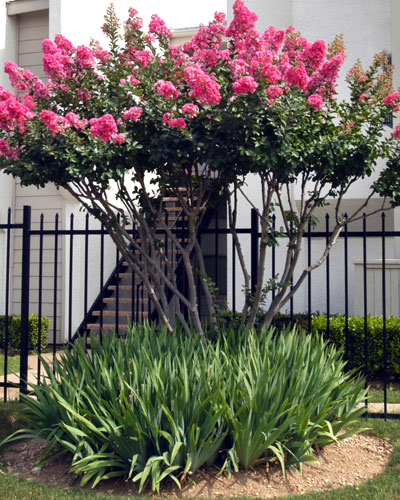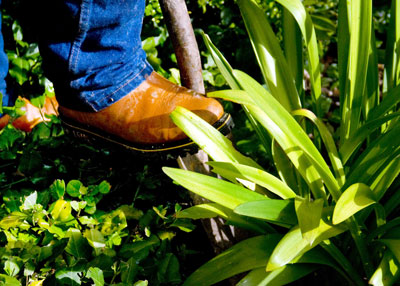If It Blooms in the Spring…
…you divide it in the fall. That goes for scores of spring-flowering perennial plants including (in rough chronological sequence of bloom time) sweet violets, candytuft, thrift, Louisiana phlox, oxalis, iris, St. Joseph’s lilies, daylilies, Shasta daisies, purple coneflowers and gloriosa daisies. It can also include mallows and cannas if you need to move them, but you’ll want to wait until cold weather kills their tops down.

Bed of iris in commercial landscape was severely overgrown and crowded last summer. Fall (now) would be the ideal time to dig and divide them.
All of these plants (and other spring-flowering perennials) establish strong roots over the winter so that they can spring out with vigorous new growth as the soil warms up in February and March. If you have any of these plants, and if they’ve begun to grow crowded, dig and divide them now before the first frost kills their tops back to the ground.
I use a small spading fork or nursery spade to lift my perennials. Most of my perennial gardens grow in soil that’s been heavily amended with organic matter and expanded shale, so I’m usually able to break the clumps of plants apart rather easily with my thumbs and the heels of my palms. In a few cases I have to use the blade of the spade to cut them in halves or quarters.

Small spading fork is the ideal tool to lift clumps of perennials such as these St. Joseph lilies.
Once I have all the plants lifted and their parts of the beds emptied, I use a mini-tiller or the spading fork to work several inches of fresh organic matter (compost, rotted manure, sphagnum peat moss and finely ground pine bark mulch) and another inch of expanded shale back into the soil.
One of the big temptations when you’re replanting is to use every one of your transplants. If you’re putting them right back where they were growing before, you’re going to have them badly over-crowded. Either create a new and larger space for them, or give them to friends. Just don’t smash them back into the same space.
I normally trim off about half of the plants’ foliage. It’s going to die with the first frost anyway, and by trimming it, I reduce the amount of stress it will put on the roots as they try to regrow. I apply a high-nitrogen fertilizer, since most of my planting soils already have enough phosphorus, but if you’re gardening in a sandy soil, you could use a root-stimulator now and pick up the nitrogen come spring.
Finish by watering deeply. I usually top off my perennial beds with a lightweight winter mulch of tree leaves I’ve run through the lawn mower.
